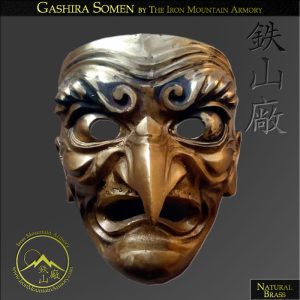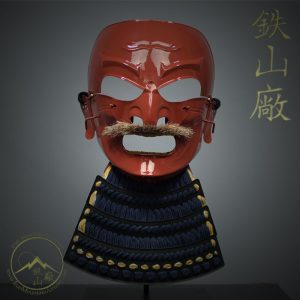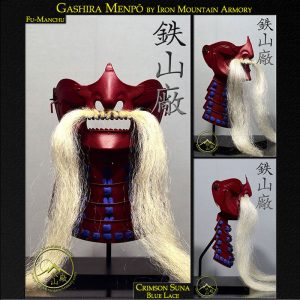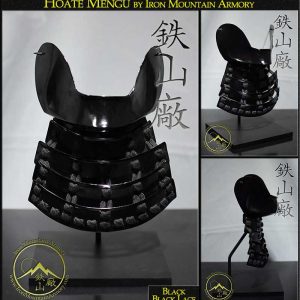- Traditionally Handcrafted
- Customizable
- Shipped Direct From The Armory
- Best Price Guarantee
- World wide delivery
Hanbo (半頬) is mengu (facial armor) that covers the chin and lower cheek area which was developed during the Nanboku-chō period (1336 ~ 1392). This new form of mengu replaced the happuri (open face mask) and would eventually lead to the hoate then menoshita-bô (目の下頬) or “menpo“. It is believed that during the Muromachi period (1336 ~ 1573), the hanbô or hôate respectively would be equipped with a nodowa or tate to protect the throat area. During the late Muromachi period onward, it became more popular to add a nose to the mengu for some added protection. However the hanbo would remain popular on the battle field. Despite lacking protection for the nose, it was far more practical as it didn’t impede vision or breathing.
The menpo was traditionally used, not only to protect the face in battle, but to help hold the cords of the kabuto (helmet) to the warrior’s head, while providing protection from the shinobi-no-o (kabuto rope). The shinobi–no-o, would typically tie around the ore kugi (L-shaped post), located on the menpo cheeks, and then down under the chin. The menpo could have a cord, which tied over the crown of the warriors head, and/or could be tied to the shinobi-no-o, to better secure it to the warrior’s face.
The Hanbo (半頬) crafted by Iron Mountain Armory is an exact replica of an antique from the late Sengoku era (467 ~ 1615) and is perfect for those wanting a more traditional Sengoku battle samurai mengu. Our samurai armorers will be honored to craft you a custom hanbo with any of the options available. Our menpo, like all of our products, are full sized and functional. It can fit your existing kabuto, or looks great displayed by itself with one of our Menpo Display Stands. It can be worn for bushido martial arts training, re-enactment, LARP, cosplay or TV production.
Features: Gashira Hanbo
[table id=236 /]
[table id=PF /]
References: “The Samurai Armour Glossary” by Ian Bottomley & David Thatcher / “The Watanabe Art Museum Samurai Armour Collection Volume 1: Kabuto & Mengu” By Trevor Absolon



